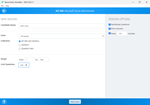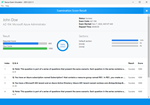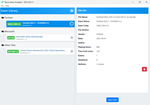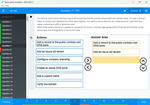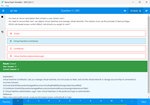Download ISTQB Certified Tester Foundation Level (Syllabus 2018).CTFL_Syll2018.VCEplus.2025-03-25.149q.tqb
| Vendor: | iSQI |
| Exam Code: | CTFL_Syll2018 |
| Exam Name: | ISTQB Certified Tester Foundation Level (Syllabus 2018) |
| Date: | Mar 25, 2025 |
| File Size: | 1 MB |
How to open TQB files?
Files with TQB (Taurus Question Bank) extension can be opened by Taurus Exam Studio.
Purchase
Coupon: TAURUSSIM_20OFF
Discount: 20%
Demo Questions
Question 1
Which of the following is NOT a factor on which test estimation is dependent upon?
- Defect debugging and resolution
- The outcome of testing of previous test cycle
- Characteristics of the development process
- Characteristics of the product
Correct answer: B
Explanation:
Test estimation is the process of predicting the effort, time, and resources required for testing a software system. Test estimation depends on several factors that influence the scope, complexity, and quality of testing. Some of these factors are:Characteristics of the product: This factor indicates how difficult or challenging it is to test the software system based on its size, functionality, reliability, usability, performance, security, etc.Characteristics of the development process: This factor indicates how well or poorly the software system is developed based on the development methodology, standards, tools, techniques, etc.Characteristics of the test process: This factor indicates how effective or efficient the testing process is based on the test strategy, plan, design, execution, evaluation, etc.Characteristics of the test team: This factor indicates how skilled or experienced the test team is based on their knowledge, competence, motivation, communication, collaboration, etc.The outcome of testing of previous test cycle is not a factor on which test estimation is dependent upon because it does not affect the effort, time, or resources required for testing the current test cycle. Rather, it is an outcome or consequence of test estimation that can provide feedback and lessons learned for improving future test estimations. You can find more information about test estimation inSoftware Testing Foundations: A Study Guide for the Certified Tester Exam, Chapter 22. Test estimation is the process of predicting the effort, time, and resources required for testing a software system. Test estimation depends on several factors that influence the scope, complexity, and quality of testing. Some of these factors are:
Characteristics of the product: This factor indicates how difficult or challenging it is to test the software system based on its size, functionality, reliability, usability, performance, security, etc.
Characteristics of the development process: This factor indicates how well or poorly the software system is developed based on the development methodology, standards, tools, techniques, etc.
Characteristics of the test process: This factor indicates how effective or efficient the testing process is based on the test strategy, plan, design, execution, evaluation, etc.
Characteristics of the test team: This factor indicates how skilled or experienced the test team is based on their knowledge, competence, motivation, communication, collaboration, etc.
The outcome of testing of previous test cycle is not a factor on which test estimation is dependent upon because it does not affect the effort, time, or resources required for testing the current test cycle. Rather, it is an outcome or consequence of test estimation that can provide feedback and lessons learned for improving future test estimations. You can find more information about test estimation inSoftware Testing Foundations: A Study Guide for the Certified Tester Exam, Chapter 22.
Question 2
Which of the following is a task of the Test Analysis and Design activity of the test process?
- Measuring the percentage of prepared test cases with what was actually prepared
- Identifying necessary test data to support the test conditions and test cases
- Verifying that the test environment has been set up correctly
- Checking test logs against the exit criteria specified in test planning
Correct answer: B
Explanation:
The Test Analysis and Design activity of the test process is the activity where test conditions and test cases are identified and specified based on the test objectives and criteria. The Test Analysis and Design activity also involves identifying and preparing the necessary test data and test environment to support the test execution. Some of the tasks of the Test Analysis and Design activity are:Reviewing the test basis: This task involves reviewing the requirements, specifications, design documents, or other sources of information that form the basis for testing.Identifying test conditions: This task involves identifying what needs to be tested based on the test basis and objectives.Designing and prioritizing test cases: This task involves designing specific scenarios or steps to verify each test condition and assigning priorities to them based on their importance or risk level.Identifying necessary test data to support the test conditions and test cases: This task involves identifying what data is needed to execute each test case and how to obtain or generate it.Identifying and preparing the test environment: This task involves identifying what hardware, software, network, data, tools, etc., are needed to execute the test cases and how to set up and maintain them.Measuring the percentage of prepared test cases with what was actually prepared is not a task of the Test Analysis and Design activity because it does not involve identifying or specifying anything related to testing. Rather, it is a task of the Test Monitoring and Control activity, which involves measuring and reporting the progress and status of testing against the planned activities and criteria. You can find more information about the Test Analysis and Design activity inA Study Guide to the ISTQB Foundation Level 2018 Syllabus, Chapter 31. The Test Analysis and Design activity of the test process is the activity where test conditions and test cases are identified and specified based on the test objectives and criteria. The Test Analysis and Design activity also involves identifying and preparing the necessary test data and test environment to support the test execution. Some of the tasks of the Test Analysis and Design activity are:
Reviewing the test basis: This task involves reviewing the requirements, specifications, design documents, or other sources of information that form the basis for testing.
Identifying test conditions: This task involves identifying what needs to be tested based on the test basis and objectives.
Designing and prioritizing test cases: This task involves designing specific scenarios or steps to verify each test condition and assigning priorities to them based on their importance or risk level.
Identifying necessary test data to support the test conditions and test cases: This task involves identifying what data is needed to execute each test case and how to obtain or generate it.
Identifying and preparing the test environment: This task involves identifying what hardware, software, network, data, tools, etc., are needed to execute the test cases and how to set up and maintain them.
Measuring the percentage of prepared test cases with what was actually prepared is not a task of the Test Analysis and Design activity because it does not involve identifying or specifying anything related to testing. Rather, it is a task of the Test Monitoring and Control activity, which involves measuring and reporting the progress and status of testing against the planned activities and criteria. You can find more information about the Test Analysis and Design activity inA Study Guide to the ISTQB Foundation Level 2018 Syllabus, Chapter 31.
Question 3
Given the following requirement:

Which of the following statements is NOT correct?
- 7 and 13 are boundary values for the equivalence partition including age 10.
- Thursday is a valid input boundary value
- A minimum of 6 valid test cases are derived from boundary value analysis based on input age
- $3.01 is a valid output boundary value
Correct answer: D
Explanation:
The requirement given in the image specifies an additional fee of $3 that is charged during the weekend, with some exceptions and discounts based on the age of the visitors. To test this requirement, we can use boundary value analysis, which is a specification-based test technique that involves testing the values at or near the boundaries of an equivalence partition. An equivalence partition is a set of values that are expected to be treated in the same way by the system under test. For example, based on the requirement, we can identify the following equivalence partitions for the input age:EP1: Age < 0 (invalid)EP2: Age = 0 (valid, no charge) EP3: 0 < Age < 7 (valid, no charge)EP4: Age = 7 (valid, 20% discount)EP5: 7 < Age < 13 (valid, 20% discount)EP6: Age = 13 (valid, 20% discount)EP7: 13 < Age < 65 (valid, full charge)EP8: Age = 65 (valid, 50% discount)EP9: Age > 65 (valid, 50% discount)The boundary values for each equivalence partition are the values at or near the edges of the partition. For example, the boundary values for EP3 are 1 and 6. The boundary values for EP4 are 6 and 7. The boundary values for EP5 are 7 and 12. And so on.To test this requirement using boundary value analysis, we need to select one value from each boundary and test it with different combinations of weekend and weekday. For example, we can select the following values:BV1: Age = -1 (from EP1)BV2: Age = 0 (from EP2 and EP3)BV3: Age = 6 (from EP3 and EP4)BV4: Age = 7 (from EP4 and EP5)BV5: Age = 12 (from EP5 and EP6)BV6: Age = 13 (from EP6 and EP7)BV7: Age = 64 (from EP7 and EP8)BV8: Age = 65 (from EP8 and EP9)BV9: Age = 66 (from EP9)We can then create test cases using these values and different combinations of weekend and weekday. For example:TC1: Age = -1, Weekend = Yes -> Invalid inputTC2: Age = -1, Weekend = No -> Invalid inputTC3: Age = 0, Weekend = Yes -> No chargeTC4: Age = 0, Weekend = No -> No chargeTC5: Age = 6, Weekend = Yes -> No chargeTC6: Age = 6, Weekend = No -> No chargeTC7: Age = 7, Weekend = Yes -> $2.40 ($3 - 20% discount)TC8: Age = 7, Weekend = No -> No chargeTC9: Age = 12, Weekend = Yes -> $2.40 ($3 - 20% discount)TC10: Age = 12, Weekend = No -> No chargeTC11: Age = 13, Weekend = Yes -> $2.40 ($3 - 20% discount)TC12: Age = 13, Weekend = No -> No chargeTC13: Age = 64, Weekend = Yes -> $3TC14: Age = 64, Weekend = No -> No chargeTC15: Age = 65, Weekend = Yes -> $1.50 ($3 - 50% discount)TC16: Age = 65, Weekend = No -> No chargeTC17: Age = 66, Weekend = Yes -> $1.50 ($3 - 50% discount)TC18: Age =66, Weekend = No -> No chargeTherefore, we need a minimum of18valid test cases to achieve100%boundary value coverage based on input age.$3.01 is not a valid output boundary value because it is not a possible output value based on the requirement. The output values can only be $0, $1.50, $2.40, or $3 depending on the input age and weekend status.You can find more information about boundary value analysis in [A Study Guide to the ISTQB Foundation Level 2018 Syllabus], Chapter 4, Section 4.2. The requirement given in the image specifies an additional fee of $3 that is charged during the weekend, with some exceptions and discounts based on the age of the visitors. To test this requirement, we can use boundary value analysis, which is a specification-based test technique that involves testing the values at or near the boundaries of an equivalence partition. An equivalence partition is a set of values that are expected to be treated in the same way by the system under test. For example, based on the requirement, we can identify the following equivalence partitions for the input age:
EP1: Age < 0 (invalid)
EP2: Age = 0 (valid, no charge)
EP3: 0 < Age < 7 (valid, no charge)
EP4: Age = 7 (valid, 20% discount)
EP5: 7 < Age < 13 (valid, 20% discount)
EP6: Age = 13 (valid, 20% discount)
EP7: 13 < Age < 65 (valid, full charge)
EP8: Age = 65 (valid, 50% discount)
EP9: Age > 65 (valid, 50% discount)
The boundary values for each equivalence partition are the values at or near the edges of the partition. For example, the boundary values for EP3 are 1 and 6. The boundary values for EP4 are 6 and 7. The boundary values for EP5 are 7 and 12. And so on.
To test this requirement using boundary value analysis, we need to select one value from each boundary and test it with different combinations of weekend and weekday. For example, we can select the following values:
BV1: Age = -1 (from EP1)
BV2: Age = 0 (from EP2 and EP3)
BV3: Age = 6 (from EP3 and EP4)
BV4: Age = 7 (from EP4 and EP5)
BV5: Age = 12 (from EP5 and EP6)
BV6: Age = 13 (from EP6 and EP7)
BV7: Age = 64 (from EP7 and EP8)
BV8: Age = 65 (from EP8 and EP9)
BV9: Age = 66 (from EP9)
We can then create test cases using these values and different combinations of weekend and weekday. For example:
TC1: Age = -1, Weekend = Yes -> Invalid input
TC2: Age = -1, Weekend = No -> Invalid input
TC3: Age = 0, Weekend = Yes -> No charge
TC4: Age = 0, Weekend = No -> No charge
TC5: Age = 6, Weekend = Yes -> No charge
TC6: Age = 6, Weekend = No -> No charge
TC7: Age = 7, Weekend = Yes -> $2.40 ($3 - 20% discount)
TC8: Age = 7, Weekend = No -> No charge
TC9: Age = 12, Weekend = Yes -> $2.40 ($3 - 20% discount)
TC10: Age = 12, Weekend = No -> No charge
TC11: Age = 13, Weekend = Yes -> $2.40 ($3 - 20% discount)
TC12: Age = 13, Weekend = No -> No charge
TC13: Age = 64, Weekend = Yes -> $3
TC14: Age = 64, Weekend = No -> No charge
TC15: Age = 65, Weekend = Yes -> $1.50 ($3 - 50% discount)
TC16: Age = 65, Weekend = No -> No charge
TC17: Age = 66, Weekend = Yes -> $1.50 ($3 - 50% discount)
TC18: Age =
66, Weekend = No -> No charge
Therefore, we need a minimum of18valid test cases to achieve100%boundary value coverage based on input age.
$3.01 is not a valid output boundary value because it is not a possible output value based on the requirement. The output values can only be $0, $1.50, $2.40, or $3 depending on the input age and weekend status.
You can find more information about boundary value analysis in [A Study Guide to the ISTQB Foundation Level 2018 Syllabus], Chapter 4, Section 4.2.
Question 4
Which of the following defect types are LEAST likely to be discovered when using static analysis tools?
- Variables that are never used
- Coding standard violations
- Memory leaks
- Uncalled functions and procedures
Correct answer: C
Explanation:
Static analysis tools are tools that examine the code or design of a software system without executing it. Static analysis tools can be used to find defects, measure complexity, check compliance, or improve quality. Some examples of defect types that can be found by static analysis tools are:Variables that are never used: This defect type occurs when a variable is declared but not referenced or assigned in the code, which indicates a waste of memory or a logic error.Coding standard violations: This defect type occurs when the code does not follow the predefined rules or conventions for formatting, naming, commenting, etc., which affects the readability and maintainability of the code.Uncalled functions and procedures: This defect type occurs when a function or procedure is defined but not called or invoked in the code, which indicates a waste of resources or a missing functionality.Memory leaks are defect types that are least likely to be found by static analysis tools because they are related to the dynamic behavior and performance of the software system. Memory leaks occur when a program does not release memory that it has allocated, causing the system to run out of memory and slow down or crash. Memory leaks can only be detected by dynamic analysis tools that monitor the memory usage of the program during execution. You can find more information about static analysis tools in [A Study Guide to the ISTQB Foundation Level 2018 Syllabus], Chapter 6, Section 6.3. Static analysis tools are tools that examine the code or design of a software system without executing it. Static analysis tools can be used to find defects, measure complexity, check compliance, or improve quality. Some examples of defect types that can be found by static analysis tools are:
Variables that are never used: This defect type occurs when a variable is declared but not referenced or assigned in the code, which indicates a waste of memory or a logic error.
Coding standard violations: This defect type occurs when the code does not follow the predefined rules or conventions for formatting, naming, commenting, etc., which affects the readability and maintainability of the code.
Uncalled functions and procedures: This defect type occurs when a function or procedure is defined but not called or invoked in the code, which indicates a waste of resources or a missing functionality.
Memory leaks are defect types that are least likely to be found by static analysis tools because they are related to the dynamic behavior and performance of the software system. Memory leaks occur when a program does not release memory that it has allocated, causing the system to run out of memory and slow down or crash. Memory leaks can only be detected by dynamic analysis tools that monitor the memory usage of the program during execution. You can find more information about static analysis tools in [A Study Guide to the ISTQB Foundation Level 2018 Syllabus], Chapter 6, Section 6.3.
Question 5
Out of the following, what is not needed to specify in defect report?
- How to fix the defect
- Severity and priority
- Test environment details
- How to reproduce the defect
Correct answer: A
Explanation:
How to fix the defect is not needed to specify in a defect report because it is not part of the information that is required to describe, reproduce, and prioritize the defect. How to fix the defect is part of the solution or resolution that is provided by the developers or maintainers who are responsible for correcting the defect. A defect report is a document that records and communicates the details of a defect found during testing. A defect report typically includes the following information:Defect ID: A unique identifier for the defectSummary: A brief description of the defectSeverity and priority: An indication of how serious and urgent the defect is Test environment details: A description of the hardware, software, network, data, tools, etc., that were used when the defect was found How to reproduce the defect: A step-by-step procedure to recreate the defect Expected and actual results: A comparison of what should have happened and what actually happened when the defect occurred Attachments: Any additional information or evidence that can help understand or resolve the defect, such as screenshots, logs, files, etc.You can find more information about defect reports in [A Study Guide to the ISTQB Foundation Level 2018 Syllabus], Chapter 5. How to fix the defect is not needed to specify in a defect report because it is not part of the information that is required to describe, reproduce, and prioritize the defect. How to fix the defect is part of the solution or resolution that is provided by the developers or maintainers who are responsible for correcting the defect. A defect report is a document that records and communicates the details of a defect found during testing. A defect report typically includes the following information:
- Defect ID: A unique identifier for the defect
- Summary: A brief description of the defect
Severity and priority: An indication of how serious and urgent the defect is Test environment details: A description of the hardware, software, network, data, tools, etc., that were used when the defect was found How to reproduce the defect: A step-by-step procedure to recreate the defect Expected and actual results: A comparison of what should have happened and what actually happened when the defect occurred Attachments: Any additional information or evidence that can help understand or resolve the defect, such as screenshots, logs, files, etc.
You can find more information about defect reports in [A Study Guide to the ISTQB Foundation Level 2018 Syllabus], Chapter 5.
Question 6
Under which of the following circumstances is maintenance testing required? [K1]
- Migration of software onto a new platform
- Testing during initial development of a replacement for an existing system
- Purchase of a new software tool
- Updating of a regression suite
Correct answer: A
Explanation:
A circumstance where maintenance testing is required is A. Migration of software onto a new platform. Migration of software onto a new platform is a type of change that affects the delivered software product and requires maintenance testing to ensure that the software product still works correctly and consistently on the new platform. A new platform can be a different hardware, operating system, network, database, browser, etc., that supports or interacts with the software product. Migration of software onto a new platform can introduce compatibility issues, performance issues, security issues, etc., that need to be detected and resolved by maintenance testing. A detailed explanation of migration testing can be found in [A Study Guide to the ISTQB Foundation Level 2018 Syllabus], page 82. A circumstance where maintenance testing is required is A. Migration of software onto a new platform. Migration of software onto a new platform is a type of change that affects the delivered software product and requires maintenance testing to ensure that the software product still works correctly and consistently on the new platform. A new platform can be a different hardware, operating system, network, database, browser, etc., that supports or interacts with the software product. Migration of software onto a new platform can introduce compatibility issues, performance issues, security issues, etc., that need to be detected and resolved by maintenance testing. A detailed explanation of migration testing can be found in [A Study Guide to the ISTQB Foundation Level 2018 Syllabus], page 82.
Question 7
Which of the following BEST defines static techniques? [K1]
- Executing the software work product
- Manually examining the code or project documentation
- Automated analysis of the code or project documentation
- Manual examination and automated analysis of code or project documentation
Correct answer: D
Explanation:
The statement that best defines static techniques is D. Manual examination and automated analysis of code or project documentation. Static techniques are techniques that analyze the code or other software artifacts (such as requirements, specifications, designs, models, test cases, etc.) without executing them, and provide information about their quality, defects, complexity, maintainability, etc. Static techniques can be performed manually or automatically by using tools or methods such as reviews, inspections, walkthroughs, checklists, standards, guidelines, static analysis tools, code metrics tools, etc. Static techniques can help to improve the quality and consistency of code or other software artifacts throughout the software development life cycle and reduce the cost and effort of testing and debugging. A detailed explanation of static techniques can be found in [A Study Guide to the ISTQB Foundation Level 2018 Syllabus], pages 27-34. The statement that best defines static techniques is D. Manual examination and automated analysis of code or project documentation. Static techniques are techniques that analyze the code or other software artifacts (such as requirements, specifications, designs, models, test cases, etc.) without executing them, and provide information about their quality, defects, complexity, maintainability, etc. Static techniques can be performed manually or automatically by using tools or methods such as reviews, inspections, walkthroughs, checklists, standards, guidelines, static analysis tools, code metrics tools, etc. Static techniques can help to improve the quality and consistency of code or other software artifacts throughout the software development life cycle and reduce the cost and effort of testing and debugging. A detailed explanation of static techniques can be found in [A Study Guide to the ISTQB Foundation Level 2018 Syllabus], pages 27-34.
Question 8
Which of the following is a role of a formal review? [K1]
- Adjudicator
- Moderator
- Governor
- Corrector
Correct answer: B
Explanation:
A role of a formal review is B. Moderator. A formal review is a type of static technique that involves a structured process of examining code or other software artifacts by a team of reviewers who follow predefined roles and rules. A formal review has four main phases: planning, preparation, meeting, and follow-up. A formal review has five main roles: author (the person who created the code or other software artifact under review), moderator (the person who leads and facilitates the review process), reviewer (the person who examines the code or other software artifact under review and provides feedback), scribe (the person who records the issues and outcomes of the review meeting), and manager (the person who monitors and controls the review process). A moderator is a key role in a formal review because he or she is responsible for planning, organizing, conducting, and reporting the review activities and ensuring that the review objectives are met. A detailed explanation of formal reviews can be found in [A Study Guide to the ISTQB Foundation Level 2018 Syllabus], pages 35-37. A role of a formal review is B. Moderator. A formal review is a type of static technique that involves a structured process of examining code or other software artifacts by a team of reviewers who follow predefined roles and rules. A formal review has four main phases: planning, preparation, meeting, and follow-up. A formal review has five main roles: author (the person who created the code or other software artifact under review), moderator (the person who leads and facilitates the review process), reviewer (the person who examines the code or other software artifact under review and provides feedback), scribe (the person who records the issues and outcomes of the review meeting), and manager (the person who monitors and controls the review process). A moderator is a key role in a formal review because he or she is responsible for planning, organizing, conducting, and reporting the review activities and ensuring that the review objectives are met. A detailed explanation of formal reviews can be found in [A Study Guide to the ISTQB Foundation Level 2018 Syllabus], pages 35-37.
Question 9
A data driven approach to test automation design is best described as:
- Using action words to describe the actions to be taken, the test data.
- Scaling to support large numbers of users.
- Being based on Equivalence Partitioning testing techniques.
- Separating out the test data inputs and using a generic script that can read the test data and perform the same test steps with different data.
Correct answer: D
Explanation:
This is the definition of a data driven approach to test automation design, which allows for reusability and maintainability of test scripts. Option A describes a keyword driven approach, which uses action words to describe the test steps and data. Option B is not related to test automation design, but rather to performance testing. Option C is also not related to test automation design, but rather to a testing technique. This is the definition of a data driven approach to test automation design, which allows for reusability and maintainability of test scripts. Option A describes a keyword driven approach, which uses action words to describe the test steps and data. Option B is not related to test automation design, but rather to performance testing. Option C is also not related to test automation design, but rather to a testing technique.
Question 10
Which of the following risks represents the highest level of risk to the project?
- Likelihood of failure = 1%, potential cost of impact = $1m.
- Likelihood of failure = 10%, potential cost of impact = $500,000.
- Likelihood of failure = 20%, potential cost of impact = $150,000.
- Likelihood of failure = 5%, potential cost of impact = $500,000.
Correct answer: B
Explanation:
Likelihood of failure = 10%, potential cost of impact = $500,000. The level of risk to the project can be calculated by multiplying the likelihood of failure by the potential cost of impact. This gives us the following values for each option:A: 1% x $1m = $10,000 B. 10% x $500,000 = $50,000 C. 20% x $150,000 = $30,000 D. 5% x $500,000 = $25,000 Likelihood of failure = 10%, potential cost of impact = $500,000. The level of risk to the project can be calculated by multiplying the likelihood of failure by the potential cost of impact. This gives us the following values for each option:
A: 1% x $1m = $10,000 B. 10% x $500,000 = $50,000 C. 20% x $150,000 = $30,000 D. 5% x $500,000 = $25,000
HOW TO OPEN VCE FILES
Use VCE Exam Simulator to open VCE files
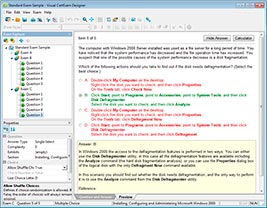
HOW TO OPEN VCEX FILES
Use ProfExam Simulator to open VCEX files
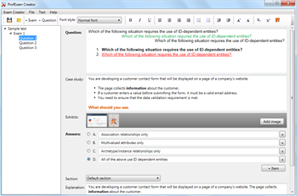
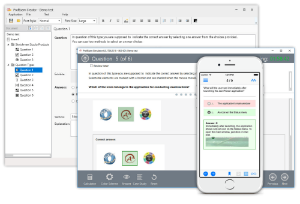
ProfExam at a 20% markdown
You have the opportunity to purchase ProfExam at a 20% reduced price
Get Now!